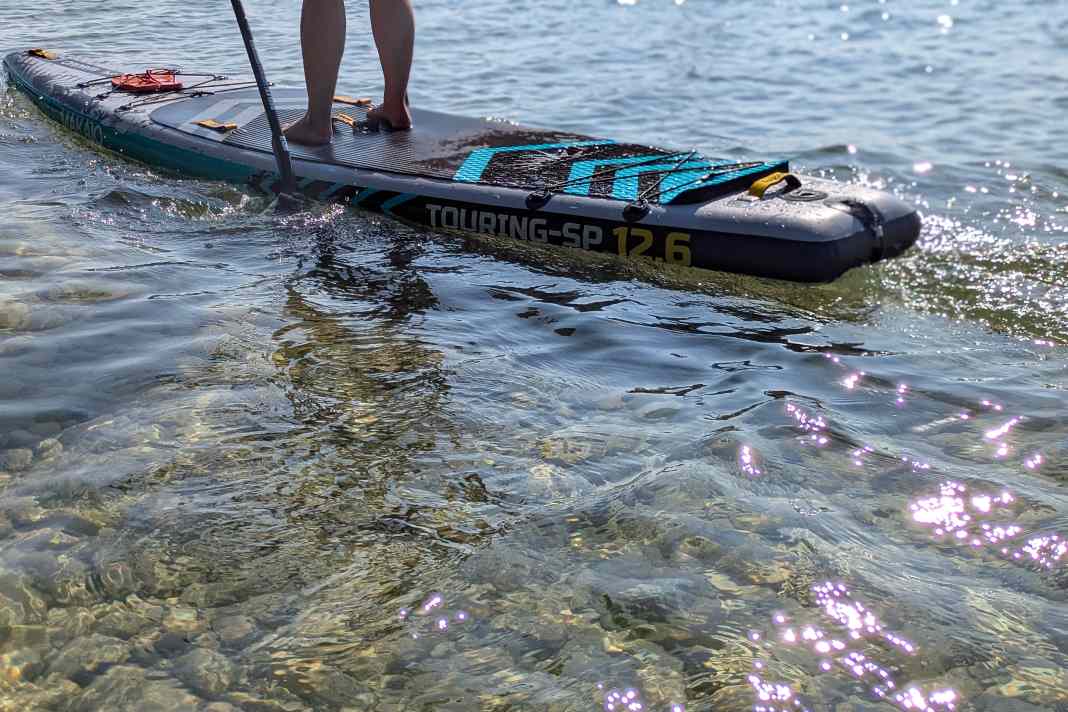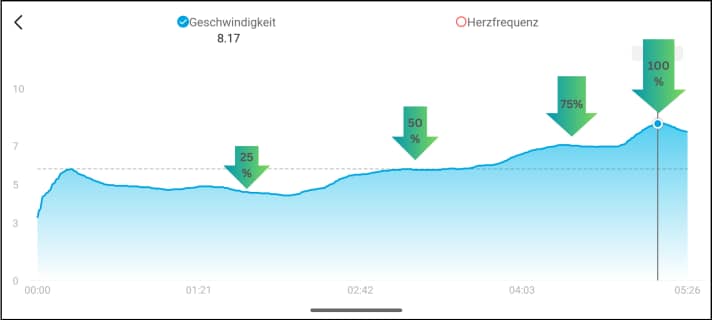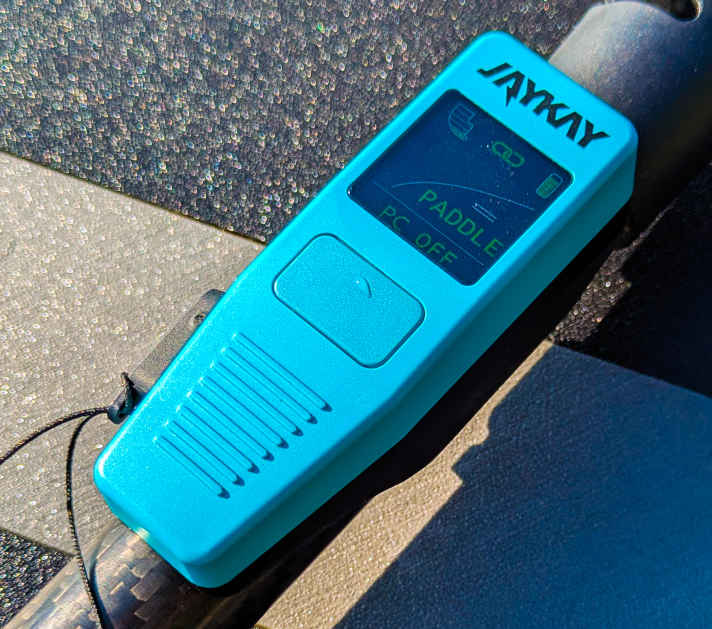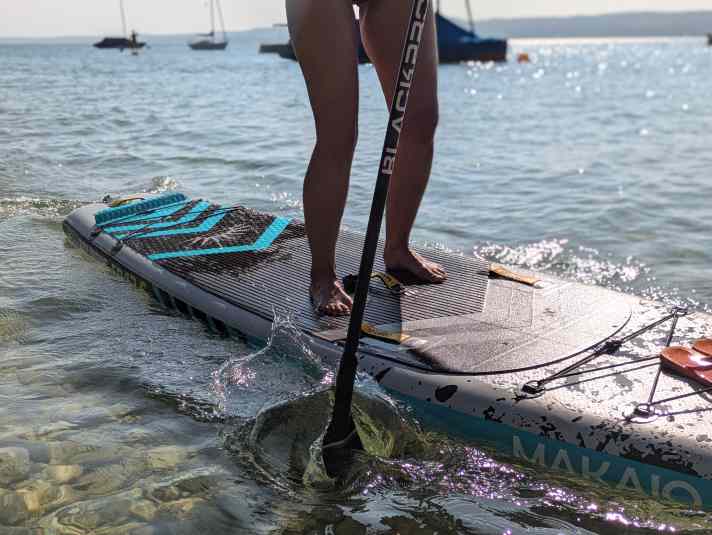Jaykay e-Finn 2.0: New electric drive for SUP boards in the endurance test!
Stephan Gölnitz
· 19.08.2025






Technical data and features
- Weight: 2 Kilo
- BatteryLi-Ion with 180 Wh, at 18 volts
- Performance of the motor: max. 360 watts, infinitely variable
- 3 operating modes:
1. Cruise (the motor pushes continuously with the selected assistance),
2. Paddle (the motor is sensor-controlled and only supports the pulling phase exactly at your paddle frequency)
3. Drive (the motor is regulated like a moped using only the slider on the controller, without paddling)
How long does the battery of the Jaykay fin last?
For the range test, we go on an open-ended excursion: we choose a well-known, beautiful route and I opt for cruise mode, in which the propeller constantly pushes with a slight whirring sound. And the iSUP gets off to a brisk start with 9 out of 18 power bars on the display. With a cruising speed of around 6.2 km/h on the speedometer, I'm actually just swinging the paddle along loosely, but the bow still throws a lively rippling bow wave onto the mirror-smooth water. It also feels like I'm travelling really fast, without paddling with any real commitment. On a 12'6'' touring iSUP, you usually have to work noticeably harder. With a pulse of just under 100, the streaks, feathers and algae in the water literally fly past the board wall - that's what makes touring fun. Because the board is propelled to around 4.8 km/h by the motor alone at around 40-50 per cent power, the remaining 1.5 km/h can be easily added with a playful paddle stroke and at a brisk pace. In between, take a sip from your water bottle and adjust your sun hat - the board keeps going.
With a medium level of support, which is already very noticeable, it was possible to paddle for just over an hour and cover a distance of almost 7 kilometres. (Stephan Gölnitz, SUP tester)
After 36 minutes and 3.5 kilometres, I reach the turning point - not bad in my opinion. The battery doesn't quite manage the way back at this level; after an hour and 5 minutes, the fin automatically switches to a very low level and then only pushes slightly for another 13 minutes. Overall, this is a good result for a fin with a battery that only weighs around 2 kilos. At 30 per cent power, the range should be even greater, and there is definitely a power saving. But just like the e-bike, the turbo mode is the most fun. The charging time of the drive, from completely empty to 100 per cent, was exactly 2.5 hours, one hour faster than stated.
It's better to switch the fin to "off" for turns, then you can get round more tightly. (Sonja Duschek, SUP tester)
How fast is the Jaykay E-Finn 2.0?
We tested the fin in a 12'6''x31'' touring iSUP in four stages with glassy water and no wind. At 12%, 50%, 75% and 100 per cent power. The paddler paddled with constant power (constant pulse) in the lowest load range.
Speed of the Jaykay fin with minimal paddle use
- @ 25 % power: 4.9 km/h
- @ 50 % power: 5.7 km/h
- @ 75 % power: 6.9 km/h
- @ 100 % power: 8.1 km/h

When sprinting at full power, the set reaches a top speed of over 9 km/h, which does not yet provide for breathtaking gliding over the water, but already seems very fast and which most i-SUPS rarely experience. At full power ahead, it really does go very quickly. However, the battery should actually run out of juice after half an hour. That's the manufacturer's specification and there's no more in terms of calculation. After another test session in mixed operation in all modes and with a high proportion of "full power", there was still a small block of battery left on the display after half an hour, which also roughly matches the technical data (motor power / battery capacity).

It's really fun, especially in the middle gears. However, you can get used to it, just like with an e-bike. (Sonja Duschek, SUP tester)
Who is an e-fin suitable for?
As with the e-bike, the main advantage of the fin is not the top speed it achieves, but the energy-saving paddle feeling at medium speeds. In addition, the supportive continuous thrust in difficult conditions - such as wind or waves - can make progress noticeably more comfortable and safer.
- Paddling beginners and children in particular can make safe progress on their own, even in moderate to medium headwinds.
- Paddlers of different strengths can paddle better together
- Medium-length tours of one to 1.5 hours can be enjoyed in a very relaxed manner and you will make faster progress

What are the disadvantages of the Jaykay E-Finn 2.0?
- Not permitted everywhere (categorised as an "electric boat" on most Bavarian lakes, Lake Constance, etc.)
- Controller display is quite scratch-sensitive
- Board is difficult to carry with the fin mounted (the handle is no longer in the centre of gravity)
- High resistance of the thick "fin" when the battery is empty
Test summary of the Jaykay E-Finn 2.0
The Jaykay E-Finn 2.0 is a successful further development and can impress on the water in a number of disciplines. Especially in difficult conditions (headwind, crosswind, wavy water), when progress is difficult, the motor pushes continuously. This also helps to keep you on course and you don't immediately go backwards when paddling into a headwind. Even a low level of assistance of 30 to 40 per cent is very noticeable. You should expect a range of around 4 to 10 kilometres, depending on how much extra power you allow yourself.

